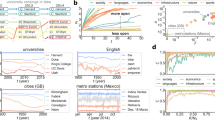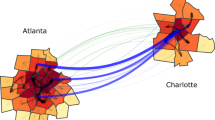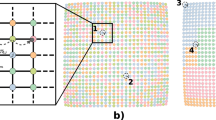Abstract
Many objects and events, such as cities, firms and internet hubs, scale with size1,2,3,4 in the upper tails of their distributions. Despite intense interest in using power laws to characterize such distributions, most analyses have been concerned with observations at a single instant of time, with little analysis of objects or events that change in size through time (notwithstanding some significant exceptions5,6,7). It is now clear that the evident macro-stability in such distributions at different times can mask a volatile and often turbulent micro-dynamics, in which objects can change their position or rank-order rapidly while their aggregate distribution appears quite stable. Here I introduce a graphical representation termed the ‘rank clock’ to examine such dynamics for three distributions: the size of cities in the US from ad 1790, the UK from ad 1901 and the world from 430 bc. Our results destroy any notion that rank–size scaling is universal: at the micro-level, these clocks show cities and civilizations rising and falling in size at many times and on many scales. The conventional model explaining such scaling on the basis of growth by proportionate effect cannot replicate these micro-dynamics, suggesting that such models and explanations are considerably less general than has hitherto been assumed.
This is a preview of subscription content, access via your institution
Access options
Subscribe to this journal
Receive 51 print issues and online access
$199.00 per year
only $3.90 per issue
Buy this article
- Purchase on Springer Link
- Instant access to full article PDF
Prices may be subject to local taxes which are calculated during checkout




Similar content being viewed by others
References
Blank, A. & Solomon, S. Power laws in cities population, financial markets and internet sites: Scaling and systems with a variable number of components. Physica A 287, 279–288 (2000)
Gabaix, X. & Ioannides, Y. M. in Handbook of Regional and Urban Economics Vol. 4 (eds Henderson, V. & Thisse, J-F.) 2341–2378 (North-Holland, Amsterdam, 2004)
Axtell, R. L. Zipf distribution of U.S. firm sizes. Science 293, 1818–1820 (2001)
Adamic, L. A. & Huberman, B. A. Zipf’s law and the internet. Glottometrics 3, 143–150 (2002)
Stanley, M. H. R. et al. Scaling behavior in the growth of companies. Nature 379, 804–806 (1996)
White, D. R., Kejzar, N., Tsallis, C. & Rozenblat, C. Generative Historical Model of City-Size Hierarchies: 430BCE–2005 (ISCOM Working Paper, Institute of Mathematical Behavioral Sciences, University of California, Irvine, CA, 2005)
Barabasi, A-L. The origin of bursts and heavy tails in human dynamics. Nature 435, 207–211 (2005)
Gibson, C. Population of the 100 Largest Cities and Other Urban Places in the United States: 1790 to 1990 (Population Division Paper 27, US Bureau of the Census, Washington DC, 1998)
Zipf, G. K. Human Behavior and the Principle of Least Effort (Addison-Wesley, Cambridge, Massachusetts, 1949)
CDU census website. 〈http://census.ac.uk/cdu/〉 (accessed 8 August, 2006)
Chandler, T. Four Thousand Years of Urban Growth: An Historical Census (Edward Mellon, Lampeter, UK, 1987)
Ioannides, Y. M. & Overman, H. G. Zipf’s law for cities: An empirical examination. Reg. Sci. Urban Econ. 33, 127–137 (2003)
Havlin, S. The distance between Zipf plots. Physica A 216, 148–150 (1995)
Guerin-Pace, F. Rank-size distribution and the process of urban growth. Urban Stud. 32, 551–562 (1995)
Robson, B. T. Urban Growth: An Approach (Methuen, London, 1972)
Theil, H. Statistical Decomposition Analysis (North-Holland, Amsterdam, 1972)
Batty, M. Entropy in spatial aggregation. Geogr. Anal. 8, 1–21 (1976)
Gell-Mann, M. & Tsallis, C. Nonextensive Entropy-Interdisciplinary Applications (Oxford Univ. Press, New York, 2004)
Turchin, P. Historical Dynamics: Why States Rise and Fall (Princeton Univ. Press, Princeton, New Jersey, 2003)
Gabaix, X. Zipf's law for cities: An explanation. Q. J. Econ. 114, 739–767 (1999)
Sornette, D. & Cont, R. Convergent multiplicative processes repelled from zero: Power laws and truncated power laws. J. Phys. I (Paris) 7, 431–444 (1997)
Pumain, D. in Hierarchy in Natural and Social Sciences (ed. Pumain, D.) 169–222 (Springer, Dordrecht, 2006)
Gibrat, R. Les Inégalités Économiques (Librarie du Recueil, Sirey, Paris, 1931)
Malcai, O., Biham, O. & Solomon, S. Power-law distributions and Levy-stable intermittent fluctuations in stochastic systems of many autocatalytic elements. Phys. Rev. E 60, 1299–1303 (1999)
Krapivsky, P. L. & Redner, S. Statistics of changes in lead node in connectivity-driven networks. Phys. Rev. Lett. 89, 258703 (2002)
Acknowledgements
This work was partially supported by the EPSRC Spatially Embedded Complex Systems Engineering Consortium. I thank R. Carvalho for useful discussions, and D. Dorling for providing the UK data set.
Author information
Authors and Affiliations
Corresponding author
Ethics declarations
Competing interests
Reprints and permissions information is available at www.nature.com/reprints. The author declares no competing financial interests.
Supplementary information
Supplementary Notes
This file contains Supplementary Discussion and Supplementary Figures. (PDF 1600 kb)
Rights and permissions
About this article
Cite this article
Batty, M. Rank clocks. Nature 444, 592–596 (2006). https://doi.org/10.1038/nature05302
Received:
Accepted:
Published:
Issue Date:
DOI: https://doi.org/10.1038/nature05302
This article is cited by
-
Dynamics of ranking
Nature Communications (2022)
-
Modeling the dynamics and spatial heterogeneity of city growth
npj Urban Sustainability (2022)
-
Issues with Spatial Scale in Urban Research
Chinese Geographical Science (2022)
-
Analysing the spatial structure of urban growth across the Yangtze River Middle reaches urban agglomeration in China using NPP-VIIRS night-time lights data
GeoJournal (2022)
-
The emergence of heterogeneous scaling in research institutions
Communications Physics (2021)
Comments
By submitting a comment you agree to abide by our Terms and Community Guidelines. If you find something abusive or that does not comply with our terms or guidelines please flag it as inappropriate.



